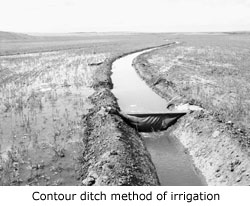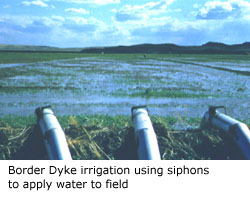Irrigation Methods
Surface Irrigation
Contour Ditch
This method consists of free flooding from ditches running approximately on a contour and
spaced 25
to 90 metres apart. The labor cost is high and the efficiency low for this method and it is only
used on
rough land with variable slopes where more efficient methods are not practical.
Border Ditch
In this method parallel ditches are run down the field 25 to 40 metres apart and the strip between
is
irrigated by turning water into the strip at any number of ditch locations. Since the water is
applied at
several downfield locations, slope can be overcome by turning water onto the strip at the high
spots.
On the other hand, labor requirements are relatively high and the ditches pose a weed problem
and are
inconvenient for farming operations.

Spring Flood
Spring flood, as its name implies, consists of controlling the spring runoff by impounding the
water on
the land until the soil reservoir is full and then releasing it. This method is usually used to
increase
production on low-lying hay lands and in most years there is only the one application in the
spring. The
system may consist simply of a dyke with a control gate in it across the lower end of the flat
which
impounds the water and back floods the low land. More sophisticated systems control and
regulate the
flow of water through a series of dykes. The cost is relatively low and increases in yield need not
be
dramatic to meet the added expense.
Border Dyking
This method consists of parallel dykes 10 to 15 centimetres high, from 10 to 20 metres apart,
running
down the field slope. Water is turned into the strip at the top end and, spreading between the
dykes,
runs down the full length of the strip. Border dykes can be used on most crops and are especially
suited
to forage crops. This method requires the greatest degree of land grading, but it can be most
efficient,
with very low labor costs. It is usually limited to land having a down-field slope less than two per
cent.
Lengths of run in general are from 245 to 400 metres.

Furrows and Corrugations
These methods utilize small channels running down field which are usually spaced one metre
apart. They
are generally used for row crops and are especially suitable for soils that are subject to surface
crusting,
because only a portion of the ground surface is flooded. Corrugations are small furrows used for
closeseeded crops on lands of slightly irregular topography. Slightly smaller stream sizes are used
than
in the furrow method.
Labor costs are generally higher than for border dyking and irrigation time is somewhat slower,
depending to a large extent on the capital expended in providing the water supply to the channels.
Land
grading requirements for furrows or corrugations are usually substantially less than for border
dykes.
Basin
This method is based on the rapid application of irrigation water to a level or nearly level area
enclosed
by dykes. The desired amount of water is turned into the basin and is retained by the dykes until
infiltrated into the soil.
Trickle
Trickle or drip irrigation is a new method, in which the entire field is irrigated at once on a
continuous or
nearcontinuous flow basis. The water is applied to the ground surface near the plants by low-flow
drippers or tricklers fed by small-diameter plastic pipe.

